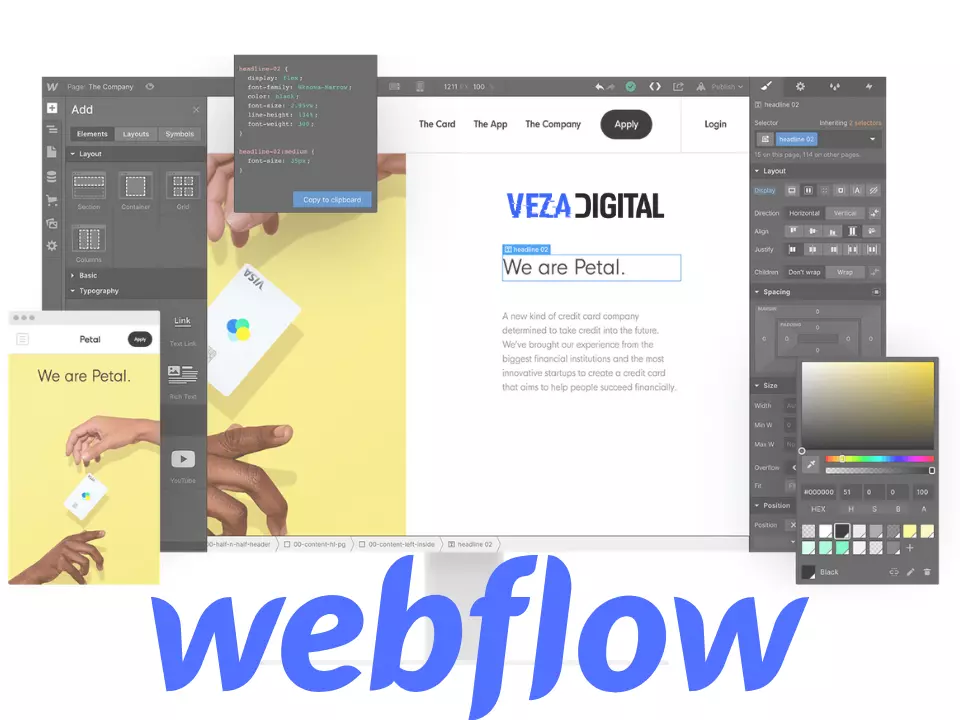
How To Do SEO On A Webflow Site
BLOG
- 13min
Category:
Web Design
Date:
December 26, 2019

It’s only natural that you want your website to look great. The thing is, Google doesn't grant rank points automatically just for looking good. That's where SEO comes in. There are a number of steps involved with this process and it can be confusing at times as well because no two websites have the same needs when it comes down to optimizing them on search engines like Yahoo or Bing, let alone what works best with Google Analytics It may seem like an overwhelming prospect at first but don't fret, let’s go through the steps.
Step 1: Having correct heading structure
It’s important that your website is structured properly with H1-H6. What does that mean? Heading 1 (H1) is the main heading, which should be front and center on your website. Google will look for this first to determine what content goes where! You can only have one per page because a newspaper article never has more than one headline, so why should you confuse both yourself and readers by having multiple heads of information in different sections? Next up are headings 2 through 6 to break things down into small chunks so it's easier for Google search engine crawlers as well as viewers alike when they're looking over everything you've posted online about who YOU ARE or WHAT YOU DO
It is vital to have clear headings in order for readers and search engines alike. The H1 header should be the most important because it allows you to include your keywords, boost relevance for important search terms, anchors the page; while also drawing in a reader who may find these headlines interesting enough to keep reading on from there. Just as if they were scanning through newspapers at their local coffee shop or bookstore - someone would look first at the headline that piqued their interest before continuing with any of those other articles beneath them- well, this website needn't worry about losing out on potential viewers!
Step 2: Optimize title tags and meta descriptions
It's very important that you have a title tag and meta description on each page of your website. The difference between the two is really straightforward: Title tags are what show up in Google search results, so use keywords or keyword phrases found in H1s for those pages to grab attention from searchers! Your meta descriptions should be short blurbs about the content of the page, mentioning any relevant keywords as well.
This is the first thing a user will see when they type a search into Google. The title tag and the meta description are what a person will use to decide if they will click on your website based on whether they think it’ll be useful to them. Don’t get lazy with your title tags or meta descriptions either as Google doesn’t like duplicates, so this might result in you getting penalised.
Step 3: Clear navigation structure
This is an easy way to make your website more user-friendly! By placing tabs at the top of your page and links within the text, navigation becomes much easier. You should also include a footer with all contact information for quick access when needed. This will increase traffic on any given day because people are able to find what they need quickly without having to search through long pages or scroll up and down endlessly trying not to get lost in another tab's content.
Having clear menus and footers makes it easy when Google crawls your site to see all your individual pages. This will also hopefully mean Google can list all of your pages in its search engine. Clear navigation is great for people too. No one enjoys spending 10 minutes trying to find contact information on a business’ website, so don’t make it difficult otherwise they’ll look elsewhere.
Step 4: Change your Webflow settings
Webflow has settings that can automatically help your website's SEO. Under Settings, there is a page called 'Hosting'. Scroll down to the bottom of that page to ‘Advanced Publishing Options’ and make sure all four are set as "ON". The last one should be left at "OFF."
You're probably thinking that you don't need to know this, but it's useful. You might not think about your website performance often; after all, the better of a job someone does at optimizing their site for speed and accessibility (and trust us when we say these two things go hand-in-hand), the fewer people will abandon them in favor of another option with faster loading time.
Step 5: Auto-generate sitemap
Google can see all the content you have and understand how it’s organized, which is why creating one is crucial for SEO. What Webflow does is auto-generate a sitemap that makes your life much easier. You’ll be able to generate a sitemap under the ‘SEO’ settings and all you have to do is click YES. A sitemap is a list of all the URLs on your website with information about them, making it easier for Google to crawl. The metadata that tells google how your web pages are related will make it much easier for them because they can see everything we offer here which makes our lives much more simple!
By auto-generating a sitemap for your website, you’ll then be able to go into Google Search Console and request for Google to crawl your site. If you don’t request this, sometimes it can take up to five weeks for Google to recognise a new website that needs to be crawled. Sometimes websites are never crawled because this request was never made, which is why making a sitemap is so important.
Step 6: Create a Google Search Console Account
You know what they say, "if it's free and Google-created, why not?" This is a free tool that Google has created, so why not use it? As we mentioned before, you’ll need to use Google Search Console (GSC) to request Google to crawl it. Once you’ve set up your website, set up an account on GSC. Then, click on the ‘Sitemaps’ tab and type in ‘sitemap.xml’. When you click ‘submit’, then you’ve notified Google that you’d like your site crawled.
Google Search Console is a free resource that you can use to track the performance of your website. Once it has been crawled by Google, they will inform you if there are any warnings or things penalizing their site so that you know what needs to change in order for them to rank well on search results pages and hopefully not get booted from first place altogether!
Get Updates every Week!
Thank you! Your submission has been received!
Oops! Something went wrong while submitting the form.






